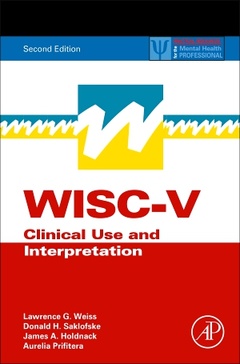Description
WISC-V (2nd Ed.)
Clinical Use and Interpretation
Practical Resources for the Mental Health Professional Series
Authors: Weiss Lawrence G., Saklofske Donald H., Holdnack James A., Prifitera Aurelio
Language: English
Subjects for WISC-V:
Keywords
WISC-V; intelligence; Flynn Effect; learning disabilities; assessment; Wechsler; dyslexia
59.52 €
In Print (Delivery period: 14 days).
Add to cart526 p. · 15x22.8 cm · Hardback
Description
/li>Contents
/li>Biography
/li>Comment
/li>
WISC-V: Clinical Use and Interpretation, Second Edition provides practical information for clinicians on the selection of subtest measures, along with their proper administration and interpretation. Full Scale IQ is identified as important for predicting relevant behaviors and primary index scores for characterizing the child?s strengths and weaknesses. Classroom indicators of low scores on each of these abilities are identified, with suggested interventions, accommodations and instructional strategies for low scorers. Coverage includes ethnic differences for the Full Scale IQ and each primary index score, along with evidence of the profound influence of parental attitudes and expectations.
Several other societal and contextual factors relevant to understanding racial/ethnic differences are presented. Two chapters review use of the WISC-V for identifying learning disabilities, testing of individuals with dyslexia, and best-practice recommendations to ensure accurate diagnosis and intervention. Concluding chapters describe advances in the Q-interactive system platform allowing administration of the WISC-V on iPads and other tablets, and how clinicians can tailor assessment using select WISC-V subtests and features.
1. WISC-V: Advances in the Assessment of Intelligence2. Practical Considerations in WISC-V Interpretation and Intervention3. Advanced Interpretation of Executive Processes with WISC-V Integrated4. Theoretical and Clinical Foundations of the WISC-V Index Scores5. WISC-V Use in Societal Context6. Testing Hispanics with WISC-V and WISC-V Spanish7. Cross Cultural Issues in Children's Intelligence: An International Perspective8. The Flynn Effect and its Clinical Implications9. WISC-V and the Evolving Role of Intelligence Testing in the Assessment of Learning Disabilities10. Translating Scientific Progress in Dyslexia into Twenty-first Century Diagnosis and Interventions11. Issues Related to WISC-V Assessment of Cognitive Functioning in Special and Clinical Groups12. Digital Assessment with Q-interactive13. WISC-V and the Personalized Assessment Approach
Dr. Weiss has presented widely on intelligence in more than a dozen countries. He has authored or co-authored the following 7 graduate level text books:
• WISC-III Cross Cultural Analyses: Culture and Children’s Intelligence (2003)
• WISC-IV Clinical Use and Interpretation (2005)
• WISC-IV Advanced Clinical Interpretation (2006)
• WISC-IV Clinical Use and Intervention (2008)
• WAIS-IV Clinical Use and Interpretation (2010)
• BAYLEY-III Clinical Use and Interpretation (2010)
• Advanced Clinical Assessment with WAIS-IV and WMS-IV (2013)
Some of his books have been translated into Spanish, Japanese, and Korean. In addition, he has authored or coauthored approximately 30 journal articles, 12 technical reports, and 10 other book chapters.
Dr. Weiss holds a PhD degree in industrial and organizational psychology from Texas A&M University, and a master’s degree in clinical psychology from Trinity University. He lives in San Antonio, Texas, with his wife of 28 years, Judy Ann. The Weiss’ have two adult sons.
Dr. Donald H. Saklofske is Professor, Department of Psychology at The University of Western Ontario, Visiting Professor at Beijing Normal University and International Research Associate, University of Florence. He is a Fellow of the Association for Psychological Science and the Canadian Psychological Associa
- Authored by the creators of the WISC-V
- Describes the new subtests, revised test structure and test extensions
- Advises clinicians on test selection
- Provides test result interpretation
- Discusses clinical applications of test use
These books may interest you

Essentials of WISC-V Assessment 57.95 €



